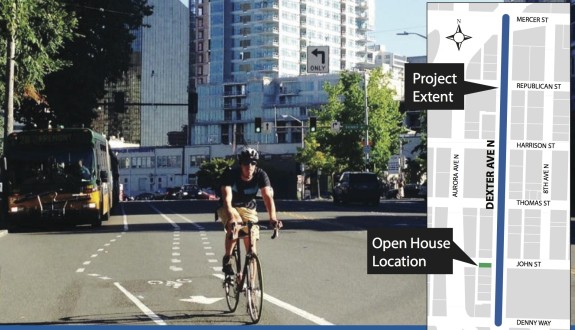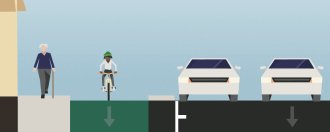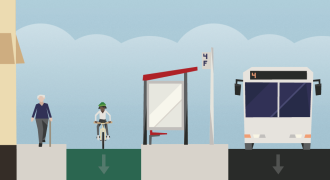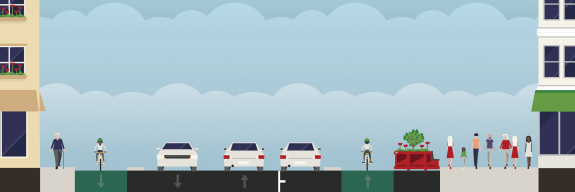
Dexter Ave may never go back to being the dangerous, super wide street it was before major construction began a few months ago between Mercer and Denny in South Lake Union.
The city is planning a road safety redesign for the street, which is a major bike route and the scene of several serious collisions including the 2011 hit and run at Dexter and Thomas that killed Mike Wang.
You can learn more and provide your thoughts on what needs to happen on Dexter at a morning-time open house from 7 to 10 a.m. August 20 at the intersection of Dexter and John.
Wang’s death on his normal bike ride home from work at PATH shook the city and ignited a movement that changed the conversation about safe streets in Seattle. Shortly after the tragedy — a hit and run that would not be solved until a year later — most the city’s conversations about bikes finally shifted away from “bikes vs cars” or the city waging a “war on cars,” and people started talking seriously about solutions.
Seattle Bike Blog helped organize a Safe Streets Social bike ride that was partly a memorial for Wang and two other people who died while biking in 2011: Robert Townsend and Brian Fairbrother. But it was also a space for people to come together and talk about their fears of traffic, their experiences with dangerous streets and their loved ones who have been killed or injured in traffic collisions no matter what mode they used to get around. Under Mayor Mike McGinn’s leadership, the city launched a Road Safety Summit that invited residents to help shape what would become the Road Safety Action Plan. That plan called for an end to traffic deaths in Seattle.
This is also the time when it became clear we needed a new Bike Master Plan, because the existing plan was not good enough to deal with the kinds of road changes needed on Dexter where Wang was killed.
In late 2011, the city to added some extra buffer space to the existing skinny bike lanes on Dexter. But people continued to get hurt, and it became clear that more would be needed to really fix the problem.
There are few solid details about what kinds of changes the city is tossing around, but protected bike lanes and adding turn lanes are among the ideas they mention on a recent mailer about the project. Dexter is an unusual challenge because unlike many other streets in the city, Dexter actually has way too much space for the relatively little motor vehicle traffic it carries. Its 13,000 vehicles per day (including bikes) is about the same as 10th Ave E on Capitol Hill, which has only two lanes.
When streets have too many lanes — and those lanes are too wide — speeding and other dangerous traffic situations occur. Over-engineered streets are dangerous and uncomfortable to cross on foot, especially for people with mobility issues, and using them is stressful for all road users, including people driving. And it’s not just Seattle Bike Blog that has been arguing for a redesign of Dexter, so has Jonathan Martin, a member of the Seattle Times Editorial Board.
But this is a great opportunity to transform the space into a wonderful and more inviting street that works better for everyone. The big question is one we don’t get asked very often in a space-crunched city: What should happen with all that extra space? Well, that depends on the project’s budget. Below are some quick ideas I put together using Streetmix (note that all measurements are approximate). Let us know your ideas in the comments, and of course let the city know during the open house.
Existing
The street is insanely wide with highway-style traffic lanes even though traffic levels are not remotely high enough to use the excess capacity. This is not a comfortable space for people, but there also aren’t very many cars. In other words, it’s all wrong.
Protected bike lanes
 The first thing the armchair traffic designers here at Seattle Bike Blog are going to do is move the parked cars to the other side of the bike lanes to turn the existing door zone, paint-only bike lanes into wide protected bike lanes.
The first thing the armchair traffic designers here at Seattle Bike Blog are going to do is move the parked cars to the other side of the bike lanes to turn the existing door zone, paint-only bike lanes into wide protected bike lanes.
And since Dexter is such a busy commute corridor, the bike lanes should definitely be built to handle all future growth in cycling. The ones pictured below are nine feet wide not including the curb. This is wide enough for side-by-side biking and for safe and easy passing. Copenhagen often builds their busiest bike lanes as wide as 13 feet.
Bus islands
 There are bus routes on Dexter, and building protected bike lanes is a chance to eliminate conflicts when buses pull across the existing bike lane to serve a bus stop.
There are bus routes on Dexter, and building protected bike lanes is a chance to eliminate conflicts when buses pull across the existing bike lane to serve a bus stop.
The solution will be no surprise to users of Dexter because it is already in place just a few blocks to the north: Bus islands. By allowing buses to stop in-lane, bus islands speed up transit times and make the buses more efficient (lots of time is lost waiting for a break in traffic so the buses can pull back into the lane). They also free up sidewalk space by moving the bus stop and people waiting into the dedicated bus space. And, of course, they remove the bike/bus conflict.
Bus islands are not exactly cheap (cost varies depending on utilities, etc), but they provide a ton of benefits and are worth every penny.
In the examples below, I do not show any bus islands, but there is space allotted for them in the on-street parking area.
The boulevard
One way to deal with the extra space is with a center median, which could have the added benefit of adding some much-needed greenery in this asphalt-heavy area. Tree canopies have been shown to reduce speeding, and the median space would make crossing the street on foot much more pleasant. But this project would likely come with a pretty hefty pricetag.
Big ass sidewalks
This option is essentially the same lane conditions as the boulevard option, but instead of a center median the extra space has been added to the sidewalks to create wonderfully wide space for walking and other sidewalk uses (sidewalk cafes, etc). This project would also not be super cheap.
Center turn lane
If the city is on a budget (and of course they are), a much lower cost option would be to include wide protected bike lanes and a painted center turn lane. Simple, intuitive and comfortable for everyone.
Sidewalk parkway
What if that extra space were dedicated to creating a long, parklike experience on one side of the street (probably the side farthest away from Aurora)? The space could have expanded walking space and greenery, benches, sidewalk cafes, a skate spot or two and any other creative and evolving use of the space people can think of. Basically, what if every day were PARK(ing) Day on Dexter?
Plus, it would nearly connect Seattle’s oldest park (Denny Park) to one of it’s newest (Lake Union Park), which would be pretty awesome.
This option does not necessarily need to be super expensive. Planters can be used to delineate the new pedestrian space if building out sidewalks is too pricey, for example. It could also be a chance for employers in the area to partner with the city the way the existing parklet project works.
 Or, if you want to really go all out, what if we took the same idea but also got rid of one lane of on-street parking to make the park space even wider?
Or, if you want to really go all out, what if we took the same idea but also got rid of one lane of on-street parking to make the park space even wider?
 Basically, there are a ton of different options that could not only make Dexter safer, but also make it a more inviting space to be. Really, doing anything else with that excess road space would be an improvement over the status quo, so it’s great that the city is not interested in returning it to its former state when construction finally settles down in the area.
Basically, there are a ton of different options that could not only make Dexter safer, but also make it a more inviting space to be. Really, doing anything else with that excess road space would be an improvement over the status quo, so it’s great that the city is not interested in returning it to its former state when construction finally settles down in the area.
Below is the open house mailer:












Comments
16 responses to “City finally planning road safety project on Dexter between Denny and Mercer”
I vote for “Big Ass Sidewalks” with parklets and bike corrals in the 30′ of unused parking space next to intersections.
Actually, probably would be best to use the 30′ to pull the protected bike lane next to the travel lanes at the intersections. Besides being safer (bicyclists more visible to right-turning drivers), the parklets and bike corrals could be next to the sidewalk.
I actually have the opposite reaction. I’d rather see the protected bike lane as far from moving traffic as possible (for comfort reasons, as well as others; see the recent SBB post about air pollution, for example). I’d like to see the bike lane between the sidewalk and the greenery in the parkway example above, for instance. There are ways to make it safe against right-turning cars without attempting to mix or have the bike & moving car lanes next to each other.
In evaluating what is and isn’t on the table it’s important to put this project in its funding context:
WSDOT has torn up the street on Dexter, and as part of repairing that there is the opportunity to reconfigure the street in terms of pavement markings – using WSDOT’s funds and construction crews. What isn’t on the table, at least based on SDOT’s presentation to SBAB earlier this month, is major in-street work such as bus bulbs (which KC Metro has indicated they may not want), or other items that would require a significant funding contribution from SDOT.
What was proposed was a road diet, with parking-buffered bike lanes, with combined bike/turn lanes in line with the NACTO design here: http://nacto.org/cities-for-cycling/design-guide/intersection-treatments/cycle-track-intersection-approach/
Why would those combined bike/turn lanes be necessary? They don’t look like they pass the “all ages and abilities” rule of thumb, are we expecting families with children to be able zipper merge with delivery trucks?
If they have limited budget why not just follow some of the same designs they will be using on 2nd? Prevent turns on some streets and replace parking lanes with turn lanes at major intersections. Have cyclists follow pedestrian signals (with signals timed at a comfortable pace.) Even if it is temporary it set the groundwork for bike signals and bus bulbs in the future. Combined with Tom’s idea for temporary materials/parklet lanes, it could be awesome and cheap.
The proposed design is actually a motor vehicle yield to bicycles configuration, rather than a zipper merge (the “mixing zone” configuration shown here http://nacto.org/wp-content/gallery/bikeboulevard_guidanceimages/cycletrackintersectionapproach_guidance.png). This is functionally the same as the bike lane/turning lane merge from Nickerson to Dexter.
I don’t think it would be any worse than the rest of Dexter, so if it’s not all-ages-and-abilities, neither is that. This is why it’s important for SDOT to prioritize its spending well, so that Westlake (and connections to/from Westlake) can be built to an all-ages-and-abilities standard.
One of the main differences between Dexter and 2nd is that Dexter has a number of unsignalized intersections. Defaulting to the approach that is proposed for 2nd would require installation of traffic signals at those intersections, which wouldn’t be appropriate for the traffic levels of Dexter and the unsignalized cross-streets (Thomas and John), and would also represent a significant cost that SDOT would need to find funding for.
I imagine it could be done at the signalized intersections, though. Not sure if that would be confusing (both to cyclists and to drivers who we would need to be relying on to obey the no-right turn except when signaled law) to have the intersection treatment vary so much.
Overall, though, this project is an opportunity to do something good in the short term to make Dexter better with State monies, not the ultimate best design long term.
It would represent another instance of the city not following the BMP when they had the opportunity. I would be very disappointed.
If a project is effectively free, would you say they shouldn’t do it because it’s not as good as a project that costs a lot? We don’t have an unlimited budget for projects.
Isn’t an incremental improvement a good thing?
Just to clarify, sorry if that came off as overly combative.
I agree that it is really disappointing that our city lacks the political will to pay for all the things that everyone agrees are worth paying for. It’s incredibly frustrating seeing all the effort that went in to the BMP and then looking at how long it would take to implement at current funding levels.
That’s precisely why this project is a good thing, though, because it makes a real improvement (just the road diet alone is a huge benefit for both bicycle, pedestrian, and even motor vehicle safety) without taking funding from other important projects.
Since the basic problem on Dexter is a road that’s far too wide for the amount of car traffic it carries, one inexpensive solution would be for the city to try putting in proper bike lanes instead of the narrow deathtraps it traditionally paints.
Make the parking lane a minimum of 8 feet wide, because common cars and trucks really are that wide with their doors closed.
To the left of the parking lane, a crosshatched door zone buffer should extend a minimum of 11 feet from the curb, discouraging bicycles from riding in this area, since that’s the door zone width of standard passenger vehicles.
To the left of the door zone buffer, the minimum width AASHTO allows for bike lanes on arterials is 5 feet. So, building a bike lane to the minimum of current standards and safety guidance, parking+buffer+bike lane = 16 feet, before any added left-side buffer between the bike lane and traffic.
Seattle cyclists accustomed to substandard bike lanes in door zones and gutters would be amazed what it feels like to ride in a proper bike lane that’s buffered from parking and actually wide enough to safely ride a bike.
(See NCHRP Report 766, “For parking lanes that are 7- to 9-ft wide, assuming the 95th-percentile parked vehicle displacement and an open door width of 45 in., the open door zone width of parked vehicles extends approximately 11 ft from the curb. Therefore, the design of the bike lane should encourage bicyclists to ride outside of this door zone area and account for the width of the bicyclist.” http://onlinepubs.trb.org/onlinepubs/nchrp/nchrp_rpt_766.pdf )
I like the tree-lined boulevard idea but unsure if that will add one more visual obstruction to the mix. I see so much U-turning on Dexter and been nearly run over a few times from drivers attempting them. I wonder if having a large barrier down the middle of the road will force those attempting U-turns to do them in specific locations that could possibly be traffic controlled with lights?
The concept of huge, wide-open streets being inherently dangerous is still a logically confusing idea to me. I always assume visual obstructions/distractions are to blame for most collisions. This stretch seems to prove my previous assumptions wrong.
I think that all things being equal, a wide open street would be safer than a street with visual obstructions, as you assume. The problem comes in the assumption of *all things being equal*.
When it comes to street width, all things are not equal. It’s a well-documented fact that the more open a street is, the more comfortable drivers are with speeding & dangerous driving, especially if the wider space translates to multiple lanes in each direction. That’s a likely explanation for why road rechannelizations in Seattle have proven so effective at reducing driver speeds and increasing safety for all road users. And it’s what leads to the somewhat counterintuitive relative safety of a road with increased visual obstruction.
Keep in mind the context:
http://www.wsdot.wa.gov/projects/viaduct/Traffic/NorthPortal
http://www.seattle.gov/dpd/cityplanning/completeprojectslist/southlakeunion/documents/default.htm
Oh look, highway on-ramps.
Seriously, Seattle?
Boulevards mostly are bad street design. Drivers that can’t see oncoming traffic tend to drive faster, and of course anything that obstructs views of oncoming bikes (whether a median or a row of parked cars) makes collisions due to failure to yield to oncoming bikes more likely! And greenery in the street median is wasted — it’s basically impossible to use, and doesn’t even cast shade far enough to affect the sidewalks on a street as wide as Dexter.
So… I wouldn’t want a full-time left-turn area, just pockets at intersections. Between those pockets. If there’s a planted area, put it next to whichever sidewalk is likely to be busier 30 years from now (probably the east one), and plant trees capable of casting shade.
IF the total effective width of the street for cars is reduced, and turn pockets make drivers’ paths a little curvy to break up the straight-line view all the way from Denny to Mercer and give turners an unhurried place to yield to oncoming traffic, speeding and hurried left turns should be reduced. At that point, a bike lane between parked cars and the sidewalk is more reasonable, though it requires removing more parking spaces around intersections and driveways to provide adequate visibility into the bike lane.
That all said, maybe the best thing for the city to do is just sell a bunch of the land. Look at the situation right now: there’s a street there and more than enough space beside it to build buildings. So build a street on one side of the ROW similar in width to the temporary street that’s there today (final configuration: two car lanes, two bike lanes, and sidewalks with a couple modest flare-outs for bus stops with bulbs). Then sell the rest to people that want to build buildings. Less street, more city, and the city makes money on the deal.
Selling off a portion of the land is my preferred solution as well. As is, Dexter is a massively wide expanse of asphalt. You could smack down buildings within that swath and still have enough room left over for streets. I’d much rather have city there than a wasteland of asphalt.
[…] project for Dexter: The City is finally planning to provide safe bicycling facilities from Mercer to Denny on Dexter […]